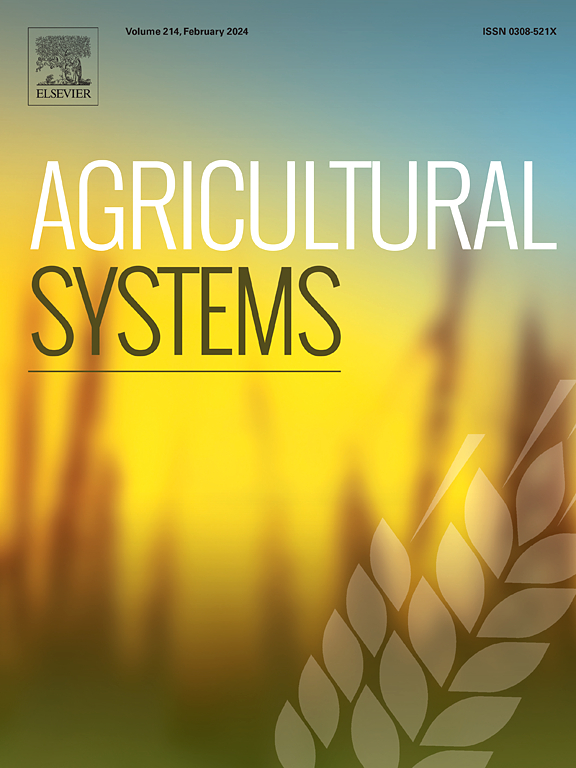从池塘到低地规模,更好地了解小规模稻鱼养殖动态的系统方法:几内亚案例研究
IF 6.1
1区 农林科学
Q1 AGRICULTURE, MULTIDISCIPLINARY
引用次数: 0
摘要
鱼类养殖支持几内亚农村生计,但由于环境条件和市场准入的差异,做法和结果差异很大。这些差异影响了农民采用先进水产养殖技术的能力,凸显了因地制宜的必要性。本研究探讨了几内亚稻鱼养殖系统的做法、制约因素和收入贡献,重点关注技术采用的驱动因素及其对家庭生计的影响。方法对1942名稻鱼养殖户进行普查,并对3个农业生态区16个养殖场的36个生产周期进行深入监测。分析包括描述性统计、Kruskal-Wallis测试、质量平衡、劳动生产率计算和半结构化访谈的定性分析。通过与鱼类价格和做法采用的统计关联,市场可达性被确定为一个重要的影响因素,并根据诸如靠近区域市场和存在鱼类批发买家等定性信息加以解释。结果与结论虽然养殖户普遍了解养鱼原则,但只有59%的养殖户使用带膜罗非鱼,30%的养殖户使用单性罗非鱼。许多人回收小鱼作为鱼种,限制了它们的生长潜力。稻鱼养殖贡献了18%的家庭收入,与水稻(22%)和种植作物(21%)相当。在城郊地区,更好的市场准入鼓励采用先进做法,从而导致价格上涨(2.5万GNF/kg,而其他地区为1.6万- 2万GNF/kg)。相比之下,草原农民面临着水资源短缺和市场连通性差等挑战,他们往往将旱季园艺整合到池塘中。意义本研究突出了农民在发展特定情境实践中的适应性。报告强调需要提供有针对性的支持,以提高几内亚稻鱼养殖系统的可持续性和复原力。本文章由计算机程序翻译,如有差异,请以英文原文为准。

From pond to lowland scale, a systemic approach to better understanding small-scale rice-fish farming dynamics: Case study in Guinea
Context
Rice-fish farming supports rural livelihoods in Guinea, but practices and outcomes vary widely due to differences in environmental conditions and market access. These disparities affect farmers' ability to adopt advanced aquaculture techniques, highlighting the need for context-specific approaches.
Objective
This study explores the practices, constraints, and income contributions of rice-fish farming systems in Guinea, with a focus on the drivers of technical adoption and their effects on household livelihoods.
Methods
A census of 1942 rice-fish farmers was combined with in-depth monitoring of 36 production cycles from 16 farms across three agro-ecological zones. Analyses included descriptive statistics, Kruskal-Wallis tests, mass balance, labor productivity calculations and qualitative analysis of semi-structured interviews. Market accessibility was identified as a significant influencing factor through statistical association with fish prices and practice adoption, and interpreted in light of qualitative information such as proximity to regional markets and the presence of wholesale fish buyers.
Results and conclusions
Although farmers generally understand fish farming principles, only 59 % use H. fasciatus and 30 % adopt monosex tilapia. Many recycle small fish as fingerlings, limiting growth potential. Rice-fish farming contributes 18 % of household income, on par with rice (22 %) and plantation crops (21 %). In peri-urban areas, better market access encourages the adoption of advanced practices, leading to higher prices (25,000 GNF/kg vs. 16,000–20,000 elsewhere). In contrast, savannah farmers face challenges such as water scarcity and poor market connectivity, often integrating dry-season horticulture into ponds.
Significance
The study highlights farmers' adaptability in developing context-specific practices. It underscores the need for tailored support to enhance the sustainability and resilience of rice-fish farming systems in Guinea.
求助全文
通过发布文献求助,成功后即可免费获取论文全文。
去求助
来源期刊

Agricultural Systems
农林科学-农业综合
CiteScore
13.30
自引率
7.60%
发文量
174
审稿时长
30 days
期刊介绍:
Agricultural Systems is an international journal that deals with interactions - among the components of agricultural systems, among hierarchical levels of agricultural systems, between agricultural and other land use systems, and between agricultural systems and their natural, social and economic environments.
The scope includes the development and application of systems analysis methodologies in the following areas:
Systems approaches in the sustainable intensification of agriculture; pathways for sustainable intensification; crop-livestock integration; farm-level resource allocation; quantification of benefits and trade-offs at farm to landscape levels; integrative, participatory and dynamic modelling approaches for qualitative and quantitative assessments of agricultural systems and decision making;
The interactions between agricultural and non-agricultural landscapes; the multiple services of agricultural systems; food security and the environment;
Global change and adaptation science; transformational adaptations as driven by changes in climate, policy, values and attitudes influencing the design of farming systems;
Development and application of farming systems design tools and methods for impact, scenario and case study analysis; managing the complexities of dynamic agricultural systems; innovation systems and multi stakeholder arrangements that support or promote change and (or) inform policy decisions.
 求助内容:
求助内容: 应助结果提醒方式:
应助结果提醒方式:


